The basic construction materials required for marine work are: cement; aggregates (sand and stones); reinforcing steel; rubble; timber or steel piles; fastenings; timber wales or sections; and some other minor items.
Cement is a green-grey powder that sets hard within a few hours after the addition of water. It therefore acquires strength with time. There are many types of cement available on the market, the most common type is known as ordinary Portland cement (OPC). The most suitable type of cement for marine works, however, is sulphate-resisting cement (SRC). Cement usually comes in paper bags containing 50 kg of cement each.
To make good concrete individual pieces of stone should be bound with a cement paste to produce a mix as dense and nonporous as possible. The aggregate (both the sand and the stone) has to be hard for the concrete to be durable. Good aggregate is so hard that it can only just be scratched by a steel penknife. Concrete made with soft coral stone is not durable and will disintegrate.

Pieces of crushed aggregate are angular in shape whereas river or beach gravel is rounded. Aggregate obtained from the sea will contain salt which is harmful to concrete. Sea aggregate must, therefore, be washed repeatedly with fresh water before being used in concrete. Coral aggregate should be used only as a last resort and then only if environmental conditions permit the harvest of living coral.
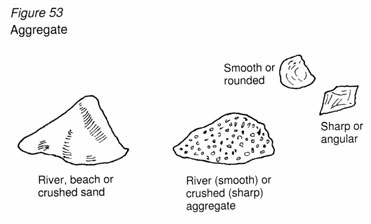
The most reliable source of stone rubble for construction is the quarry. A quarry is usually worked for a whole range of sizes of stone and the yield of the right sizes depends on the capability of the person carrying out the blasting as well as on the geological composition of the ground. As with aggregate, the durability of the concrete depends on the hardness of the stone. Again, as a general rule, a steel penknife should just be able to scratch the stone. If the stone scratches very easily, it is not suitable for breakwaters, quays or any structure in contact with sea water and a supply of harder stone should be sought.
Reinforcing steel is used inside a concrete section to make the section stronger. In marine work, the steel should have a minimum concrete cover of 50 mm to prevent sea-water corrosion. Steel bars for reinforcing concrete come in a range of diameters, from as little as 6 mm up to 32 mm. Steel bars are usually supplied by weight, in kilograms per length of bar.

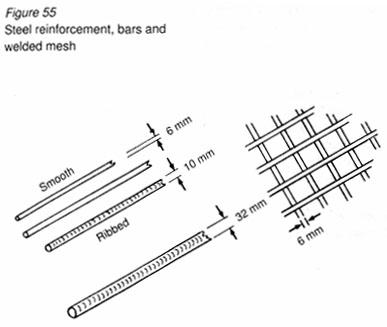
The most commonly used sizes are:
6-mm diameter, 0.222 kg/m;
8-mm diameter, 0.395 kg/m;
10-mm diameter, 0.6 17 kg/m;
12-mm diameter, 0.888 kg/m;
14-mm diameter, 1.208 kg/m;
18-mm diameter, 1.998 kg/m;
20-mm diameter, 2.466 kg/m;
24-mm diameter, 5.55 1 kg/m.
Bars are seldom more than 12 m long.
Reinforcement is also available as welded steel mesh.
Just as a good cook knows how to store ingredients to keep them fresh, careful housekeeping on the construction site will ensure that building materials remain suitable for construction purposes:
- Cement should not be stored on-site for more than six weeks. It should be used as quickly as possible.
- Cement and steel should be stored about 150 mm off the ground and covered by waterproof sheets tied down to pegs (Figure 56).
- Enough space should be left under the sheets for air to circulate. This prevents water from condensing on to the cement bags.
- Cement from punctured bags should not be used for construction.
- Cement and steel should not be stored in places where water collects in puddles after rain.
- If rain is forecast for the day, concrete work should be postponed.
- Cement, cement paste and fresh concrete should not be touched with bare hands. Cement in any of these forms may crack bare skin and lead to bleeding and infection.
In marine construction frequent use is made of piles in either steel, timber or reinforced concrete (Figure 57).
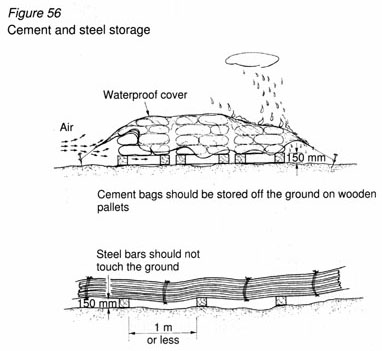
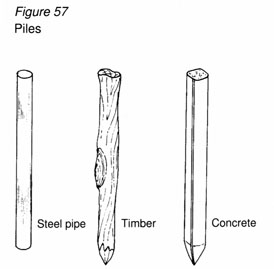
Piles are necessary when the ground is very soft (as in a marsh or swamp or on a muddy river-bed). In these cases a number of piles are driven into the ground to form a stable foundation.
To avoid deterioration, all piles must be protected; steel piles should be painted with special epoxy paints, timber piles should be treated with creosote oil and concrete piles should be made with sulphate-resisting cement (SRC).
Fastenings are required for holding timber sections together. Depending on the size of the timber sections, the fastenings used can be either bolts or screws. Nails should not be used, because when they corrode they snap suddenly without warning.
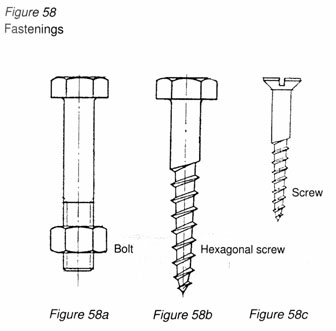
Figure 58a shows a hexagonal bolt which must be made of either
galvanized steel or, better still, of brass or stainless
steel.
Figure 58b shows a heavy-duty hexagonal screw, again made of
brass or galvanized steel.
Figure 58c shows a normal countersunk screw which is also
available in brass.
Nowadays, the basic construction material is concrete. The science of mixing the ingredients to make concrete is called mix design. A proper mix is one that produces a dense and strong concrete that is durable and resistant to the elements. Such a mix is a balanced recipe composed of cement, fine aggregate (sand), coarse aggregate (stone) and fresh water.
Cement. As described earlier, the cement should be OPC or, better still, SRC. In any case it should not be older than six weeks.
Fine aggregate. Sand should be either washed beach-sand or crushed aggregate from a nearby quarry. Whichever is used it must be free from excessive quantities of silt and dust.
Coarse aggregate. The pieces of stone aggregate should not be larger than 50 mm each. They must be hard, non-porous and free from excessive quantities of dust. Coral should net be used for aggregate because it is too soft, porous and contains sea-salt which is harmful to steel reinforcing bars.
Water. The water used in the concrete mix should be clean, fresh drinking water free from any impurities such as salt.
Proportions of cement and aggregates
The proportion of cement to aggregate depends on the strength, impermeability and durability of concrete required. Experience has shown that a concrete mix of 1:2:4 (that is, for every one part of cement used, two parts of sand and four of stone aggregate are used) is suitable for general construction purposes in terms of both cost and strength. Workable mixtures that are richer in cement, for example, a 1:1:2 mix, are much stronger but more expensive because of the higher cement content.
Instead of simply using a rich mixture it is generally more economical to obtain the necessary quality of concrete by careful grading and mixing of the aggregates and water in a normal 1:2:4 mix.
The 1:2:4 concrete mix by weight. Using a standard 50-kg bag of cement as the base measure, a 1:2:4 mix by weight contains 50 kg of cement, 100 kg of sand and 200 kg of stone aggregate. However, as it is not always possible to weigh such large amounts of aggregate, an equivalent mix by volume may be used.
Equivalent mix by volume. To every 50-kg bag of cement, 0.07 m3 of sand and 0.14 m3 of stone should be added.
Mixing by volume. To mix the materials, a
wooden measure box should be constructed with inside dimensions
of 400 mm x 400 mm x 200 mm (Figure 59). Sand or coarse aggregate
can then be shovelled into the box and a straight edge run over
the top as shown in Figure 59.
Each such level box contains 0.035 m3 of sand or
coarse aggregate. Therefore, a 1:2:4 mix is equivalent to:

Depending on the size of the concrete mixer, the batching or mixing should follow these proportions. So, if the mixer is big, for every two bags of cement, four boxes of sand and eight boxes of stone should be added.
Adding Water
The strength and workability of concrete depend to a great
extent on the amount of water used in mixing. For each mix there
is an optimum amount of water that produces the concrete of
greatest possible strength.
If less water is used the workability of the concrete
decreases and it becomes too stiff to work. Using more than the
optimum amount of water increases the workability of the concrete
(by making it more fluid) but decreases its strength and
durability.
The optimum amount of water is influenced by:
- The origin and quality of the aggregate; concrete with porous aggregate requires more water than normal.
- The amount of silt or dust in the sand.
- The humidity of the aggregate; if the aggregate was exposed to rain the previous day then less water is required.
The best way of calculating the optimum amount of water required to make the strongest possible concrete is to carry out trial tests by adding water bit-by-bit to the mixer and testing the concrete as follows.
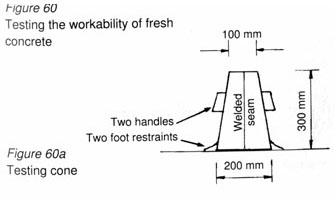
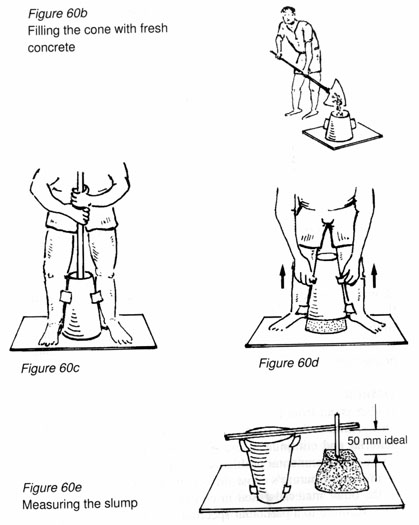
First, construct an open-ended truncated cone from a piece of smooth, thin sheet-metal, following the dimensions shown in Figure 60a. Ideally, the seam of the cone should be welded vertically down one side and two handles should be welded to either side; one pair of handles near the top and one near the bottom of the cone. The inside should then be rendered very smooth. Remember that the inside should be kept well-oiled to prevent it from rusting.
When just enough water has been added to the concrete mixer to make the concrete appear wet but stiff, the cone should be filled with three layers of concrete, each compacted by hand using a steel bar 20 mm in diameter. The top should then be trowelled level and the cone lifted off. As soon as the steel cone is lifted off, the concrete will slump or settle down as shown in Figure 60. The ideal slump for most practical purposes is 50 mm, that is, the top of the concrete cone will sink 50 mm.
Should the concrete not slump by 50 mm, a bit more water should be added to the mixer and the whole test repeated until the slump reaches 50 mm. Water should be added 0.5 litre at a time by means of a measuring can and not directly with a water hose. See Annex 1 for tips on the handling and placing of concrete.
Timber is cut from trees, which are the products of nature and time. Humans have found timber to be a cheap and useful material and continue to use it in vast quantities. However, serious environmental problems can be caused by the overuse or misuse of nature's most important products. Unlike many of the other materials used in construction, timber cannot be manufactured to a particular specification. So, the best use has to be made of the material that already exists.
Durability is defined here as timber's ability to resist attack from salt-water, corrosion of metal fastenings, fungi and insect attack. A tree trunk consists of two distinct sections; the inner section, or heartwood, and the outer section, or sapwood (Figure 61). In some hardwoods, the sapwood is characterized by vessels or pores of large diameter, and only a few fibres are present.
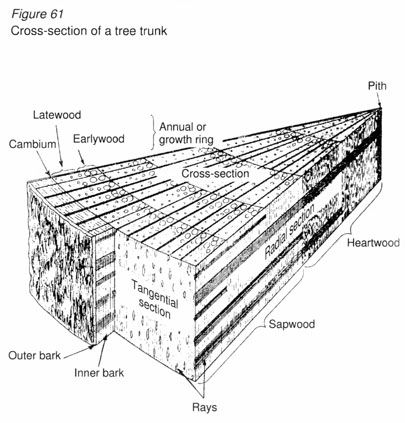
In the heartwood, the pore diameter is considerably smaller and the bulk of the tissue comprises fibres. Therefore, only heartwood, with its low porosity, is suitable for marine work.
Marine-borers
Timber used in sea or brackish (salty) water is subject to
attack by marine-boring animals such as the shipworm and the
gribble (Figure 62). Marine-borers are widely distributed, but
they are particularly destructive in tropical waters. Most
timbers have to be specially treated to protect them from
marine-borers. Figure 62 shows how the gribble and the shipworm,
or Teredo, destroy timber structures.
Some timbers, however, are naturally resistant to marine-borers. Some particularly resistant types of timber grow wild in tropical rain forests. Tropical rain forests, however, are a non-renewable source of timber that is fast disappearing. They should, therefore, be protected from exploitation and preference should be given to species grown in plantations, which are a renewable source. Table 1 lists some marine-borer resistant timbers and the continents where they grow.
As well as being very dense and only very slightly porous, the heartwood of these species secretes toxic substances which protect it from marine-borer attack. It can therefore be used untreated for marine piling and jetty construction.
Table 1
Marine-borer resistant timbers
| Continent | Source | Common name |
| Africa | Plantation | Opepe |
| Asia | Plantation | Teak |
| Australia | Indigenous | Ironbark |
| Australia | Plantation | Southern blue gum |
| South and Central | Rain forests | Greenheart |
| America | Rain forests | Red louro |
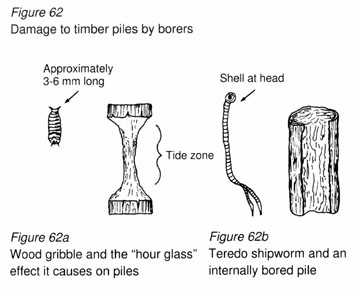
On the other hand, the sapwood of the above species is more
porous and lacks the protective toxic secretions.
For marine work it is always advisable to use timber that has
been impregnated under pressure with preservatives. Suitable
preservatives are coal-tar creosote, creosote/coal-tar solutions
and copper/chrome/arsenic waterborne mixtures. Experience has
shown that when timber is thoroughly impregnated with one of
these preservatives it will last a very long time. For this
reason it is best to choose a timber that is easy to treat. The
treatment should be repeated by dipping after the sections have
been cut and holes drilled into them.
Environmental conditions and timber resources vary from place to place, so advice should be sought from the nearest forest products commission or office regarding the most suitable renewable timber to use.
Durability
Durability in marine work is defined in the broadest sense.
The decay resistance of most timbers varies a great deal and even
pieces cut from the same tree will often show wide differences.
However, timbers have been classified into five broad grades,
based on the performance of their heartwood in contact with the
ground:
- Very durable timber will not start to decay until it has been in contact with the ground for more than 25 years.
- Durable timber will last for 15 to 25 years.
- Moderately durable timber lasts for 10 to 15 years.
- Non-durable timber lasts for 5 to 10 years.
- Perishable timber decays within five years.
Timber in direct contact with sea or brackish water (jetty piles for example) should be heartwood of one of the species listed as very durable, opepe or ironbark, for example (Table 2).
Table 2
Durability of different timbers
| Moderately durable (10-15 years) |
Durable 15-25 years |
Very durable (over 25 years) |
| Hardwoods | ||
| Oak | Agba | Afrormosia |
| Sapele | Idigbo | Afzelia |
| Seraya | Mahogany1 | Ekki |
| Walnut2 | Oak3 | Greenheart |
| Mahogany4 | Chestnut | Iroko |
| Jarrah | ||
| Makore | ||
| Opepe | ||
| Teak | ||
| Softwoods | ||
| Larch | Pitch pine | |
| Douglas fir | Yew | |
| Pine5 | Western red cedar |
Notes:
1 American
2European and African
3European
4African
5 Maritime.
Remember that all sapwood is perishable, unless treated. Only the
heartwood of the species in the last column is naturally
resistant to marine-borers.
Timber used externally but not in direct contact with sea or brackish water (the jetty deck, for example) may be durable or moderately durable, such as oak, chestnut, Douglas fir or maritime pine, which has been treated with a preservative.
A bath for dipping timbers into preservatives can be made from a series of oil drums split in half and welded together (Figure 63). The timber sections to be treated should first be cut to the required size and bolt holes drilled at the appropriate points. Each section should then be immersed in a bath of preservative, such as coal-tar creosote, for at least 24 hours. After the required treatment, the timber should be allowed to dry before handling.
